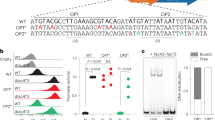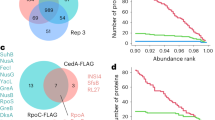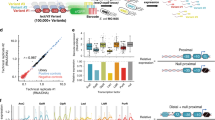Abstract
Non-inducible tetracycline repressor (TetR) mutants were grouped in three structurally distinct classes. We quantitated in vivo operator binding, inducibility, and in vitro tetracycline binding of mutants from each class. Mutation of residues close to tetracycline (class 1) leads to reduced affinity for the drug. Mutation of residues located at the connection of the DNA-reading head with the protein core (class 2) and at the dimerization interface (class 3) bind inducer with the same affinity as wild-type TetR. These mutations interfere with the induced, but not the operator-binding conformation of TetR. The affinity of some class 1 mutants for tetracycline is less affected than their inducibility, suggesting that the mutated residues are important for triggering those conformational changes necessary for induction.
This is a preview of subscription content, access via your institution
Access options
Subscribe to this journal
Receive 12 print issues and online access
$189.00 per year
only $15.75 per issue
Buy this article
- Purchase on Springer Link
- Instant access to full article PDF
Prices may be subject to local taxes which are calculated during checkout
Similar content being viewed by others
References
Parkinson, J.S. Signal transduction schemes of bacteria. Cell 73, 857–871 (1993).
Parkinson, J.S. & Kofoid, E.C. Communication modules in bacterial signalling proteins. Annu. Rev. Genet. 26, 71–112 (1992).
Heyduck, T. & Lee, J.C. Application of fluorescence energy transfer and polarization to monitor Escherichia coli cAMP receptor protein and lac promoter interaction. Proc. natn. Acad. Sci. U.S.A. 87, 1744–1748 (1990).
Schultz, S.C., Shields, G.C. & Steitz, T.A. Crystal structure of a CAP-DNA complex: the DNA is bent by 90°. Science 253, 1001–1007 (1991).
Somers, W.S. & Philips, S.E.V. 1992. Crystal structure of the met repressor-operator complex at 2.8 Å resolution reveals DNA recognition by β-strands. Nature 539, 387–393 (1992).
Arvidson, D.N. Interaction of the Escherichia coli Trp aporepressor with its ligand, L-tryptophan. J. Biol. Chem. 261, 238–243 (1986).
Zhang, H. et al. The solution structure of the trp repressor-operator DNA complex. J. molec. Biol. 238, 592–614 (1994).
Miller, J.H. & Reznikoff, W.S. The operon, (2nd ed., Cold Spring Harbor Laboratory Press, Cold Spring Harbor, NY; 1980).
Hillen, W., Gatz, C., Altschmied, L., Schollmeier, K. & Meier, I. Control of expression of the Tn10-encoded tetracyline resistance genes. J. molec. Biol. 169, 707–721 (1983).
Takahashi, M., Altschmied, L. & Hillen, W. Kinetic and equilibrium characterization of the Tet repressor-tetracyline complex by fluorescence measurements. J. molec. Biol. 187, 341–348 (1986).
Laiken, S.L., Gross, C.A. & von Hippel, P.H. Equilibrium and kinetic studies of Escherichia coli lac repressor-inducer interactions. J. molec. Biol. 66, 143–155 (1972).
Lin, S.-Y. & Riggs, A.D. The general affinty of lac repressor for E. coli DNA: implications for gene regulation in procaryotes and eucaryotes. Cell 4, 107–111 (1975).
Hansen, D., Altschmied, L., & Hillen, W. Tet repressor mutants with single tyrptophan residues as fluorescent probes. J. Biol. Chem. 262, 14030–14035 (1987).
Weber, I.T. & Steitz, T.A. Structure of a complex of catabolite gene activator protein and cyclic AMP refined at 2.5 Å resolution. J. molec. Biol. 198, 311–326 (1987).
Rafferty, J.B., Somers, W.S., Saint-Girons, J. & Phillips, S.E.V. Three-dimensional crystal structures of Escherichia coli met repressor with and without corepressor. Nature 341, 705–710 (1989).
Chabbert, M., Hillen, W., Hansen, D., Takahashi, M. & Bousquet, J. Structural analysis of the operator binding domain of Tn10-encoded Tet repressor: a time-resolved fluorescence and anisotropy study. Biochemistry 31, 1951–1960 (1992).
Zhao, D., Arrowsmith, C.H., Jia, X. & Jardetzky, O. Refined solution structure of the Escherichia coli trp holo-and aporepressor. J. molec. Biol. 229, 735–746 (1993).
Zhang, R.-G., Joachimiak, A., Lawson, C.L., Schevitz, R.W., Otwinowski, Z. & Sigler, P.B. The crystal structure of trp aporepressor at 1.8 Å shows how binding tryptophan enhances DNA affinity. Nature 327, 591–597 (1987).
Hinrichs, W., Kisker, C., Düvel, M., Müller, A., Tovar, K., Hillen, W. & Saenger, W. Structure of the Tet repressor-tetracycline complex and regulation of antibiotic resistance. Science 264, 418–420 (1994).
Kisker, C., Hinrichs, W., Tovar, K., Hillen, W. & Saenger, W. The complex formed between tetracycline repressor and tetracycline-Mg2+ reveals mechanism of antibiotic resistance. J. molec. Biol. 247, 260–280 (1995).
Wissmann, A., Meier, I. & Hillen, W. Saturation mutagenesis of the Tn10-encoded fef operator O1: identification of base-pairs involved in Tet repressor recognition. J. molec. Biol. 202, 397–406 (1988).
Heuer, C. & Hillen, W. Tet repressor-tet operator contacts probed by operator DNA-modification interference studies. J. molec. Biol. 202, 407–415 (1988).
Sizemore, C., Wissmann, A., Gülland, U. & Hillen, W. Quantitative analysis of Tn10 Tet repressor binding to a complete set of tet operator mutants. Nucleic Acids Res. 18, 2875–2880 (1990).
Tovar, K. & Hillen, W. Tet repressor binding induced curvature of tet operator DNA. Nucleic Acids Res. 17, 6515–6522 (1989).
Wissmann, A. et al. Amino acids determining operator binding specificity in the helix-turn-helix motif of Tn10 Tet repressor. EMBO J. 10, 4145–4152 (1991).
Baumeister, R., Helbl, V. & Hillen, W. Contacts between Tet repressor and tet operator revealed by new recognition specificities of single amino acid replacement mutants. J. molec. Biol. 226, 1257–1270 (1992).
Helbl, V., Berens, C., & Hillen, W. Proximity probing of Tet repressor to tet operator by dimethylsulfate reveals protected and accessible functions for each recognized base-pair in the major groove. J. molec. Biol. 245, 538–548 (1995).
Smith, L.D. & Bertrand, K.P. Mutations in the Tn10 Tet repressor that interfere with induction; location of the tetracycline-binding domain. J. molec. Biol. 203, 949–959 (1988).
Hecht, B., Müller, G. & Hillen, W. Non-Inducible Tet Represssor Mutations Map from the Operator Binding Motif to the C-Terminus. J. Bacteriol. 175, 1206–1210 (1993).
Goldenberg, D.P. Genetic studies of protein stability and mechanisms of folding. A. Rev. Biophys. biophys. Chem. 17, 481–507 (1988).
Wissmann, A. et al. Selection for Tn10 Tet repressor binding to fet operator in Escherichia coli: isolation of temperature-sensitive mutants and combinatorial mutagenesis in the DNA binding motif. Genetics 128, 225–232 (1991).
Markiewicz, P., Kleina, L., Cruz, C., Ehret, S. & Miller, J.H. XIV. Analysis of 4000 altered Escherichia coli lac repressors reveals essential and non-essential residues, as well as ‘Spacers’ which do not require a specific sequence. J. molec. Biol. 240, 421–433 (1994).
Ramakrishnan, C. & Srinivasan, N. Glycyl residue in proteins and peptides: An analysis. Curr. Sci. 59, 851–861 (1990).
Richmond, T. & Richards, F. Packing of α-helices: geometrical constraints and contact areas. J. molec. Biol. 119, 537–555 (1978).
Jobe, A., Riggs, A.D. & Bourgeois, S. lac Repressor-operator interactions: V. characterisation of super- and pseudo-wild-type repressors. J. molec. Biol. 64, 181–199 (1972).
Kleina, L.G. & Miller, J.H. Genetic studies of the lac repressor. XIII. Extensive amino acid replacements generated by the use of natural and synthetic nonsense suppressors. J. molec. Biol. 121, 2956–318 (1990).
Arvidson, D.N., Pfau, J., Hatt, J.K., Shapiro, M., Pecoraro, F.S. & Youderian, P. Super-repressors with alanine 77 changes. J. Biol. Chem. 268, 4362–4369 (1993).
Hurlburt, B.K. & Yanofsky, C. Enhanced operator binding by trp superrepressors of Escherichia coli. J. Biol. Chem. 265, 7853–7858 (1990).
Degenkolb, J., Takahashi, M., Ellestad, G.A., & Hillen, W. Structural requirements of tetracycline-Tet repressor interaction: determination of equilibrium binding constants for tetracycline analogs with Tet repressor. Antimicrob. Agents Chemother. 35, 1591–1595 (1991).
Takahashi, M., Degenkolb, J. & Hillen, W. Determination of the equilibrium association constant between Tet repressor and tetracycline at limiting Mg2+ concentrations: a generally applicable method for effector-dependent high affinity complexes. Analyt. Biochem. 199, 197–202 (1991).
Richardson, J.S. & Richardson, D.C. in Prediction of protein structure and the principles of protein conformation (Ed. G.D. Fasman) (Plenum Press, New York and London; 1989).
Altschmied, L., & Hillen, W. Tet repressor tet operator complex formation induces conformational changes in the tet operator DNA. Nucleic Acids Res. 12, 2171–2180 (1984).
Lederer, H., Tovar, K., Baer, G., May, R.P., Hillen, W. & Heumann, H. The quaternary structure of Tet repressors bound to the Tn10-encoded tet gene control region determined by neutron solution scattering. EMBO J. 8, 1257–1263 (1989).
Barford, D. & Johnson, L.N. The allosteric transition of glycogen phosphorylase. Nature 340, 609–616 (1989).
Altschmied, L., Baumeister, R., Pfleiderer, K. & Hillen, W. A threonine to alanine exchange at position 40 of Tet repressor alteres the recognition of the sixth base pair of fef operator from GC to AT. EMBO J. 7, 4011–4017 (1988).
Ettner, N., Metzger, J.W., Lederer, T., Hulmes, J.D., Kisker, C., Hinrichs, W., Ellestad, G.A. & Hillen, W. Proximity mapping of the Tet repressor-tetracycline-Fe2+ complex by hydrogen peroxide mediated protein cleavage. Biochemistry 34, 22–31 (1995).
Brent, R. & Ptashne, M. Mechanism of action of the lexA gene product. Proc. natn. Acad. Sci. U.S.A. 78, 4204–4208 (1981).
Berens, C., Altschmied, L. & Hillen, W. The role of the N-terminus in Tet repressor for tet operator binding determined by a mutational analysis. J. Biol. Chem. 267, 1945–1952 (1992).
Ausubel, F.M. et al. Current protocols in molecular biology. Greene Publishing Associates, (J. Wiley and Sons, New York' 1989).
Hansen, D. & Hillen, W. Tryptophan in α-helix 3 of Tet repressor forms a sequence-specific contact with tef operator in solution. J. Biol. Chem. 262, 12269–12274 (1987).
Bradford, M.M. A rapid and sensitive method for the quantification of microgram quantities of protein utilizing the principle of protein-dye binding. Anal. Biochem. 72, 1903–1906 (1976).
Perrin, D.D. & Dempsey, B. Buffers for pH and metal ion control. (Chapman and Hill Ltd., London; 1974).
Hillen, W. & Berens, C. Mechanisms underlying expression of Tn10 encoded tetracycline resistance. A. Rev. Microbiol. 48, 345–369 (1994).
Author information
Authors and Affiliations
Rights and permissions
About this article
Cite this article
Müller, G., Hecht, B., Helbl, V. et al. Characterization of non-inducible Tet repressor mutants suggests conformational changes necessary for induction. Nat Struct Mol Biol 2, 693–703 (1995). https://doi.org/10.1038/nsb0895-693
Received:
Accepted:
Issue Date:
DOI: https://doi.org/10.1038/nsb0895-693
This article is cited by
-
Mycobacterium tuberculosis FasR senses long fatty acyl-CoA through a tunnel and a hydrophobic transmission spine
Nature Communications (2020)
-
Specific binding of divalent metal ions to tetracycline and to the Tet repressor/tetracycline complex
JBIC Journal of Biological Inorganic Chemistry (2008)
-
Improved single-chain transactivators of the Tet-On gene expression system
BMC Biotechnology (2007)
-
Optimization of the Tet-On system for regulated gene expression through viral evolution
Gene Therapy (2006)
-
Observing conformational and activity changes of Tet repressor in vivo
Nature Structural Biology (2000)



